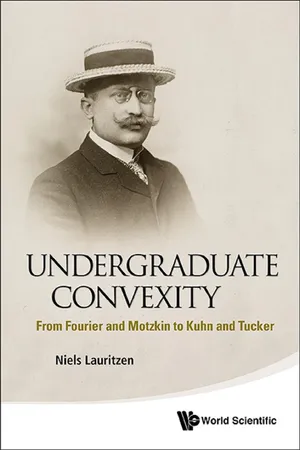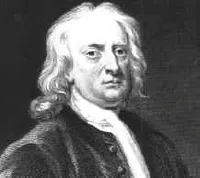
- 300 pages
- English
- ePUB (mobile friendly)
- Available on iOS & Android
eBook - ePub
About this book
Based on undergraduate teaching to students in computer science, economics and mathematics at Aarhus University, this is an elementary introduction to convex sets and convex functions with emphasis on concrete computations and examples.
Starting from linear inequalities and Fourier–Motzkin elimination, the theory is developed by introducing polyhedra, the double description method and the simplex algorithm, closed convex subsets, convex functions of one and several variables ending with a chapter on convex optimization with the Karush–Kuhn–Tucker conditions, duality and an interior point algorithm.
Contents:
- Fourier–Motzkin Elimination
- Affine Subspaces
- Convex Subsets
- Polyhedra
- Computations with Polyhedra
- Closed Convex Subsets and Separating Hyperplanes
- Convex Functions
- Differentiable Functions of Several Variables
- Convex Functions of Several Variables
- Convex Optimization
- Appendices:
- Analysis
- Linear (In)dependence and the Rank of a Matrix
Readership: Undergraduates focusing on convexity and optimization.
Frequently asked questions
Yes, you can cancel anytime from the Subscription tab in your account settings on the Perlego website. Your subscription will stay active until the end of your current billing period. Learn how to cancel your subscription.
No, books cannot be downloaded as external files, such as PDFs, for use outside of Perlego. However, you can download books within the Perlego app for offline reading on mobile or tablet. Learn more here.
Perlego offers two plans: Essential and Complete
- Essential is ideal for learners and professionals who enjoy exploring a wide range of subjects. Access the Essential Library with 800,000+ trusted titles and best-sellers across business, personal growth, and the humanities. Includes unlimited reading time and Standard Read Aloud voice.
- Complete: Perfect for advanced learners and researchers needing full, unrestricted access. Unlock 1.4M+ books across hundreds of subjects, including academic and specialized titles. The Complete Plan also includes advanced features like Premium Read Aloud and Research Assistant.
We are an online textbook subscription service, where you can get access to an entire online library for less than the price of a single book per month. With over 1 million books across 1000+ topics, we’ve got you covered! Learn more here.
Look out for the read-aloud symbol on your next book to see if you can listen to it. The read-aloud tool reads text aloud for you, highlighting the text as it is being read. You can pause it, speed it up and slow it down. Learn more here.
Yes! You can use the Perlego app on both iOS or Android devices to read anytime, anywhere — even offline. Perfect for commutes or when you’re on the go.
Please note we cannot support devices running on iOS 13 and Android 7 or earlier. Learn more about using the app.
Please note we cannot support devices running on iOS 13 and Android 7 or earlier. Learn more about using the app.
Yes, you can access Undergraduate Convexity by Niels Lauritzen in PDF and/or ePUB format, as well as other popular books in Mathematics & Applied Mathematics. We have over one million books available in our catalogue for you to explore.
Information
Chapter 1
Fourier-Motzkin elimination
You probably agree that it is easy to solve the equation

This is an example of a linear equation in one variable having the unique solution x = 2. Perhaps you will be surprised to learn, that there is essentially no difference between solving a simple equation like (1.1) and the more complicated system

of linear equations in x, y and z. Using the first equation 2x + y + z = 7 we solve for x and get

This may be substituted into the remaining two equations in (1.2) and we get the simpler system

of linear equations in y and z. Again using the first equation in this system we get

ending up with the simple equation 8z = 24. This is an equation of the type in (1.1) giving z = 3. Now z = 3 gives y = 2 using (1.4). Finally y = 2 and z = 3 gives x = 1 using (1.3).

Figure 1.1: Isaac Newton (1642–1727). English mathematician.
Solving a seemingly complicated system of linear equations like (1.2) is really no more difficult than solving the simple equation (1.1). One of the world's greatest scientists, Isaac Newton, found it worthwhile to record this method in 1720 with the words
And you are to know, that by each Æquation one unknown Quantity may be taken away, and consequently, when there are as many Æquations and unknown Quantities, all at length may be reduc'd into one, in which there shall be only one Quantity unknown.

Figure 1.2: Carl Friedrich Gauss (1777–1855). German mathematician.
During the computation of the orbit of the asteroid Pallas around 1810, Gauss encountered the need for solving linear equations related to his famous least squares method. If you spend a little time deciphering the Latin in Gauss's original writings (see Figure 1.3), you will see how elimination appears naturally towards the end of the page. In spite of Newton's explicit ...
Table of contents
- Cover
- Title Page
- Copyright
- Preface
- Acknowledgments
- 1. Fourier-Motzkin elimination
- 2. Affine subspaces
- 3. Convex subsets
- 4. Polyhedra
- 5. Computations with polyhedra
- 6. Closed convex subsets and separating hyperplanes
- 7. Convex functions
- 8. Differentiable functions of several variables
- 9. Convex functions of several variables
- 10. Convex optimization
- Appendix A Analysis
- Appendix B Linear (in) dependence and the rank of a matrix
- Bibliography
- Index